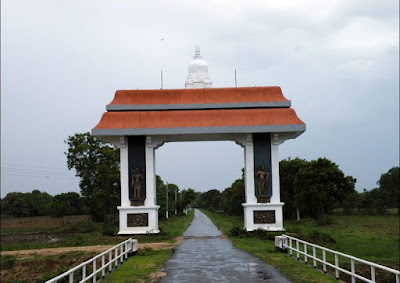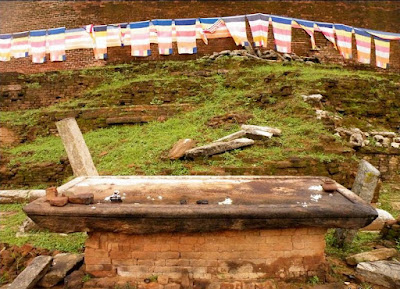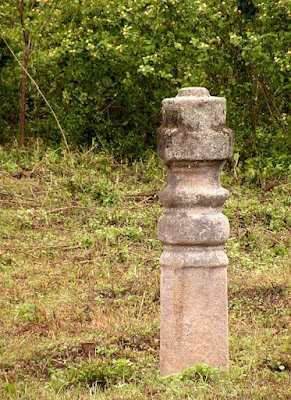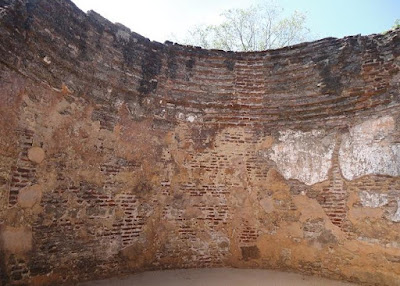Wednesday, September 25, 2013
Interference in Internal Matters of Developing Nations is Disturbing - President at UN - Nilneth.net
Interference in Internal Matters of Developing Nations is Disturbing - President at UN - Nilneth.net
Tuesday, May 28, 2013
Sunday, March 31, 2013
Deegavapi (Digavapi) Stupa -Ampara
 According to the the Mahavansa, great chronicle of Sri
Lanka, this stupa was built by king Saddhatissa (137-119 BC). According to the
same the king has also donated a jacket decorated with gold lotus flowers and
various gems to cover the stupa.
According to the the Mahavansa, great chronicle of Sri
Lanka, this stupa was built by king Saddhatissa (137-119 BC). According to the
same the king has also donated a jacket decorated with gold lotus flowers and
various gems to cover the stupa.
...... "Moreover, he founded the Dighavapi-vihara
together with the cetiya; for this cetiya he had a covering of network made set
with gems, and in every mesh thereof was hung a splendid flower of gold, large
as a wagon-wheel, that he had commanded them to fashion. (In honour) of the
eighty-four thousand sections of the dhamma the ruler commanded also
eighty-four thousand offerings. When the king had thus accomplished many works
of merit he was reborn, after his death, among the Tusita gods.”...........
 Since this location has been blessed by Buddha's presence,
it is generally believed that this stupa is a "paribogika" stupa and
no special relics have been enshrined. But historian venerable Ellawela
Medananda thero believes that this stupa enshrines a nail relic of Buddha. An
inscription on a gold foil unearthed during excavations discloses that King
Kawanthissa (164-192) has done renovations to the stupa.
Since this location has been blessed by Buddha's presence,
it is generally believed that this stupa is a "paribogika" stupa and
no special relics have been enshrined. But historian venerable Ellawela
Medananda thero believes that this stupa enshrines a nail relic of Buddha. An
inscription on a gold foil unearthed during excavations discloses that King
Kawanthissa (164-192) has done renovations to the stupa.
With passage of time, this temple was neglected with the
internal conflicts of the country. King Keerthi Sri Rajasinghe ( 1747 - 1781)
seeing the status of the temple carried out major renovations and handed it
over to Rev. Bandigide Negrodha thero along with 1000 'amunu' (2000-2500 acres)
of land in 1756. Two stone inscriptions by King Saddhasissa and King Keerthi
Sri Rajasinghe have been in existence at the Deegavapi until last century but
both of these have mysteriously disappeared now. But a copy of the Rajasinghe
inscription which was made in 1845 exists today.
 During British occupation of the country, the british took
over all the land belonging to the temple and the in 1886 the British
government agent in Batticaloa instructed to dig this 2000 year old stupa and
carried the bricks and ancient granite slabs to be used in irrigation projects
in the area. The british used the Muslims in the area to do his work as no
Buddhist would take part in this destruction of this revered site. In the end
only a mound was left over of this great stupa and was left to the jungle.
During British occupation of the country, the british took
over all the land belonging to the temple and the in 1886 the British
government agent in Batticaloa instructed to dig this 2000 year old stupa and
carried the bricks and ancient granite slabs to be used in irrigation projects
in the area. The british used the Muslims in the area to do his work as no
Buddhist would take part in this destruction of this revered site. In the end
only a mound was left over of this great stupa and was left to the jungle. In 1916 a priest called Kohukumbure Revatha thero started
searching for this stupa and he found some muslims carrying bricks in carts.
When inquired, he was told that they were from a great brick mound deep in the
jungle. He followed these cartsmen and found the Dageba in absolute ruins. He
came back with few buddhists from colombo and started redeveloping this temple
area and also managed to reclaim 250 acres of land back to the temple. By this
time, Deegavapi area were dominated by Muslims who were given refuge in this
area by King Senerath (1604 - 1635) when they were harassed in the coastal
areas by the Portuguese. The king not only gave them refuge, but destroyed a
portuguese fort at the port called "Deegavapi Thitha" for them to
carry out their business activities freely. But in 1950 Kohukumbure Revatha
thero was brutally murdered by a Muslim in the area.
In 1916 a priest called Kohukumbure Revatha thero started
searching for this stupa and he found some muslims carrying bricks in carts.
When inquired, he was told that they were from a great brick mound deep in the
jungle. He followed these cartsmen and found the Dageba in absolute ruins. He
came back with few buddhists from colombo and started redeveloping this temple
area and also managed to reclaim 250 acres of land back to the temple. By this
time, Deegavapi area were dominated by Muslims who were given refuge in this
area by King Senerath (1604 - 1635) when they were harassed in the coastal
areas by the Portuguese. The king not only gave them refuge, but destroyed a
portuguese fort at the port called "Deegavapi Thitha" for them to
carry out their business activities freely. But in 1950 Kohukumbure Revatha
thero was brutally murdered by a Muslim in the area.Saturday, March 30, 2013
Rankoth Vehera Stupa - Polonnaruwa
Friday, March 29, 2013
Pothgul viharaya

This
is the oldest library complex found in Sri Lanaka. Pothgul means for place to
store books. This viharaya was billed by king Parakamabahu the Great (1153-1185
AD). This was renovated by Queen Chandrawathi.
A consort of King Parakarmabahu.
Pothgul Viharaya is a Gedige type structure, build in the middle of the square shape stage. The interesting point in this building is the circular structure in the middle, seems the main library, made out of brick. The circular shape roof even made out of bricks it seems. There are remaining of four small stupas at the four corners of the floor. Out of it there are remaining of the several buildings which were used as awasa ( residential cells where Bikkus live).
Pothgul Viharaya desig is closer to the most of the old vihara found in Cambodia.
Pothgul Viharaya Plan
Pothgul
Viharaya - Circular Structure made out of bricks
Residential cells where Bikkus lived
View from
back side
Tuesday, February 26, 2013
Bomburu Ella - The Widest Waterfall in Sri Lanka
 Bomburu Ella is in Uva - Paranagama provincial division of
Badulla District of Sri Lanka. Bomburu Ella is one of the most beautiful
waterfall in Sri Lanka and Not only that is the Widest Waterfall in Sri Lanka.
Bomburu Ella is in Uva - Paranagama provincial division of
Badulla District of Sri Lanka. Bomburu Ella is one of the most beautiful
waterfall in Sri Lanka and Not only that is the Widest Waterfall in Sri Lanka.
The waterfall is 50 Meters (165 feet) in height and waters
of Bomburu Ella has been diverted to a powerhouse in that area and also for
cultivation purposes. The waterfall originated from Kotakithula Mountain(2015
meters) and the walk towards the fall is a interesting one. Its Extremely
dangerous to bath in this waterfall because of its rapid water flow.
In the colonial times Bomburu Ella was called "Fort
Mcdonald River" and later it was called Pomuruella Oya, Dalgala Oya and
Dulgaha Oya.

Thursday, February 21, 2013
Nuwara Eliya
Nuwara
Eliya is a mountain station at 1,868 m (6,128 ft) of altitude, in a splendid
landscape. The city pretends to be particularly well-kept and neat, and the
always green grass gives to the locality an aspect of “colonial British
style".
Nuwara
Eliya was built entirely during the 19th century and its architecture mimics
that of an English country town, with red-brick walls, country house like hill
club and mock-Tudor half-timbering.
Blessed
with salubrious climate, breathtaking views of valleys, meadows, mountains and
greenery; it's hard to imagine that Nuwara Eliya is only 180 Km from the hot
and humid Colombo. Temperatures are 14C-21C (Jan- April) 16C-18C (May-Aug) 15C-
18C (Sept-Dec).
Thursday, February 14, 2013
Nawagamuwa Pattini Devalaya(Sri Sugathabimbaramaya)
Among
the archaeologically significant sites in the Colombo District, Nawagamuwa
Devale is important as a historic place of worship. Legend has it that the
origin of this Pattini devale close to the Kelani river goes back to the early
Anuradhapura period.
But,
due to destruction by foreign forces and reconstruction over the years, little
visible proof remains to confirm this belief. However, archaeological research
has revealed several sites in the Nawagamuwa area to confirm that settlements
in the area date back to a B.C. era.
When
the early Aryan settlements were being established, Kelani river and Kelani
thota were of importance. Nawagamuwa is located at the 13th milepost on the old
Colombo - Ratnapura road. It is believed that during the early Anuradhapura
period, Nawagamuwa belonged to the Kelani kingdom.
According
to a popular legend, when King Gajaba 1 (A.D. 114 - 136) came from India with
12,000 men as prisoners, bringing with him a Pattini anklet, he alighted at the
landing place close to the devale. It is said that he built a devale, enshrined
the anklet and held poojas here. From then till the Kotte period no significant
facts have been discovered about the site.
During
the Kotte period, the area was known as Hewagam Korale, according to
Rajavaliya. It is said that when Rajasinghe I fought the Portuguese forces at
Mulleriyawa, his last camp was pitched here. After his victory, he named the
area Hewagam Korale in gratitude to the Hewagama soldiers who came to his aid.
During this period, it is said, Nawagamuwa was used as a jetty on the road
connecting Colombo Fort with Malwana, Hanwella and Gurubebili. The Pattini
Devale was then famed as the Pattini Kovil. The first historical mention of the
Nawagamuwa Pattini Devale is found during the Kotte period. Mention is made in
the 'Godagama Sannasa', made known by Buwanekabahu V (A.D. 1521 - 1580), of a
royal decree for a gift of oil to be made for the Nawagamuwa Pattini Kovil
perahera.
Ancient
devale
During
the Sitawaka period too this area was historically important. It is noted that
when King Mayadunne (A.D. 1521 - 1580) set out to fight the Portuguese in the
Colombo Fort, he stopped on his way at the Nawagamuwa Pattini Devale to make a
vow before he went to war. According to Portuguese reports, in 1550, the
Portuguese king sent 600 troops to help King Buwanekabahu V. They clashed with
King Mayadunne at Nawagamuwa. It is also recorded that in 1576, the Portuguese
army destroyed Nawagamuwa Devale and established an army camp there. The devale
was rebuilt by King Mayadunne only to be destroyed again by the Captain of the
Colombo fort, leaving a pile of ruins.
 Mr.
A.E.L.Tillekewardene of the Archaeological Department says that according to
popular beliefs and historical data, Nawagamuwa devale was known as a pilgrim
site from the beginning of the 15th century. Excavations around the devale from
time to time unearthed building materials, wells, Dutch coins and iron
implements of the middle ages. North of the old devale at what was known as the
old landing place, coins used during the Dutch period in Ceylon, 1554 - 1765,
have been found. Old stone posts have been found discarded on some of the
private properties in the vicinity. Signs that a pier or similar erection had
existed on a large flat rock by the riverside, have also been uncovered. These
archeological artifacts were discovered when construction work on a suspension
bridge across the river was in progress. The Archaeological Department then
stepped in and construction has been discontinued until further research on the
site is carried out.
Mr.
A.E.L.Tillekewardene of the Archaeological Department says that according to
popular beliefs and historical data, Nawagamuwa devale was known as a pilgrim
site from the beginning of the 15th century. Excavations around the devale from
time to time unearthed building materials, wells, Dutch coins and iron
implements of the middle ages. North of the old devale at what was known as the
old landing place, coins used during the Dutch period in Ceylon, 1554 - 1765,
have been found. Old stone posts have been found discarded on some of the
private properties in the vicinity. Signs that a pier or similar erection had
existed on a large flat rock by the riverside, have also been uncovered. These
archeological artifacts were discovered when construction work on a suspension
bridge across the river was in progress. The Archaeological Department then
stepped in and construction has been discontinued until further research on the
site is carried out.
During
recent research conducted in the Nawagamuwa Devale area, remains of several
buildings of the Kotte period and some buildings of the 19th century have been
identified. The Department has declared eight archeologically important sites
as protected monuments to be conserved. These sites are the Viharaya or
Pilimage, the monks' abode or Sanghavasaya, Galkanu devale, Maha Pattini
Devale, Vishnu, Kataragama and Dedimunda devales and the grove of ancient Na
trees, which is over 100 years old.
When
Sri Sumanatissa Himi first came to Nawagamuwa he built a small cadjan thatched
dwelling place or 'Awasaya' at 'Thanayamwatte', where the fruit stalls are now.
This place was known as thanayamwatte because there had been a rest house for
travellers there. The autobiography of the learned Kalukonduwawe Sri
Pagnasekera Nahimi, who was a student of Shri Sumanatissa Himi, describes the
temple constructions undertaken by his guru. According to this the old name of
the devale was Sri Sudarsharamaya, which was later changed to Sri
Sugathabimbaramaya. It was Sri Sumanatissa Himi who also constructed a
permanent abode for the monks.
 After
constructing the Galkanu devale, Sri Sumanatissa Himi constructed the monks
abode or Sanghavasaya and the Vihare or Pilimage in 1894. The Maha Pattini
devale and the Dharma shalawa were constructed later.
After
constructing the Galkanu devale, Sri Sumanatissa Himi constructed the monks
abode or Sanghavasaya and the Vihare or Pilimage in 1894. The Maha Pattini
devale and the Dharma shalawa were constructed later.
The
facade of the Sanghavasaya, an old 19th century British period building is
unfortunately defaced by the construction of a nondescript extension.
The
Maha Pattini devale, which is the main devale on the premises is also from the
19th century but the front section had been added more recently. A gold plated
statue of the goddess Pattini is enshrined within. Outside the Maha devale, is
an old 'Asana' stone, dating back to the Kotte period, which is not in its
original setting. The other five shrines stand in a row.
Of
these the Vishnu, Kataragama and Dedimunda devales are of the 19th century
while Saman and Moratu devales have been constructed recently.
The
Archaeological Department has declared these important sites protected
monuments to be preserved for future generations. Architectural conservation of
the buildings is also being undertaken to preserve them in their original style
as far as possible. Extensions such as the one to the Sanghavasaya would not be
permitted in future.
Wednesday, February 13, 2013
Peradeniya Botanic Gardens
Peradeniya
Botanic Gardens,
botanical garden in Peradeniya, near Kandy, Sri Lanka, noted for its rich and
varied collections of tropical woody plants. Occupying 59 hectares (146 acres),
it has about 4,000 species of plants. The most important specimens of the
garden include palms, some of which are planted in impressive avenues. Significant,
too, are the collections of orchids, gymnosperms, and flowering trees.
The
gardens were founded in 1821 primarily to introduce coffee trees and various
other tropical plants of economic importance to the region. Even after it took
on a more botanical emphasis in the 1840s, the garden remained a center for
horticultural activities. Under the directorship of the botanist George H.K.
Thwaites, the garden played a pivotal role in establishing the country’s
flourishing tea industry in the late 1870s. Thwaites also brought in and
cultivated the Brazilian rubber tree, which became a crop producer vital to Sri
Lanka’s economy. The botanical collection has developed into one of the finest
in the region.

Subscribe to:
Posts (Atom)





